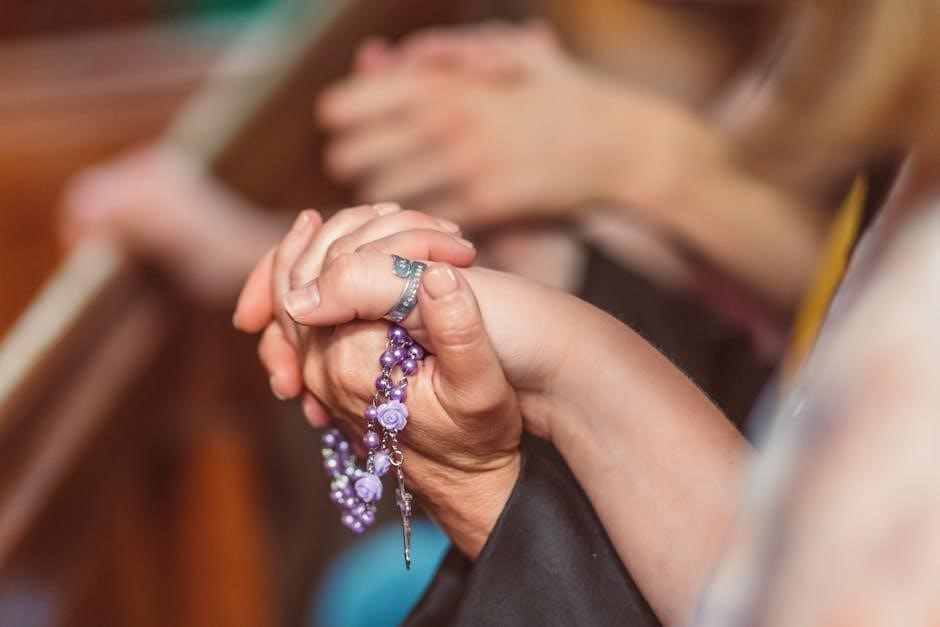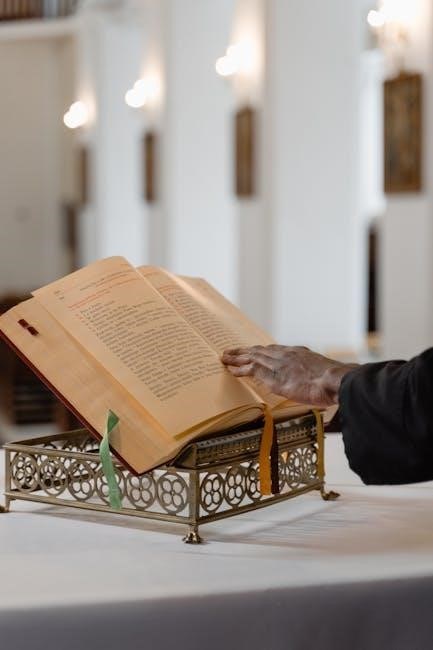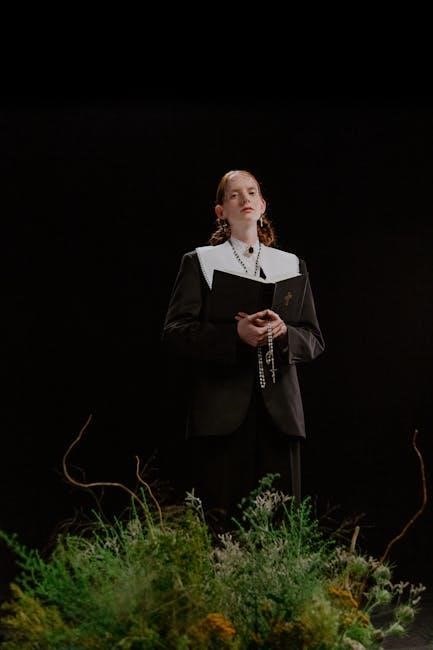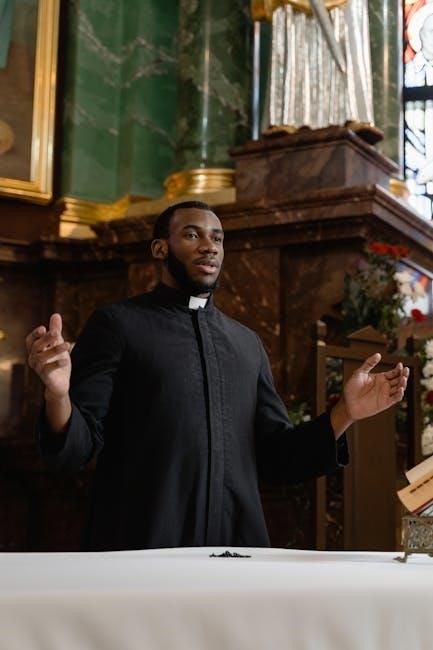
The Holy Rosary is a traditional Catholic prayer that combines meditation on biblical events with devotional prayer. It reflects on the life of Christ through the eyes of Mary‚ fostering spiritual growth and peace.
What is the Holy Rosary?
The Holy Rosary is a traditional Catholic devotion that combines prayer and meditation. It is a sequence of prayers recited while reflecting on key events in the life of Jesus Christ and the Virgin Mary. The Rosary consists of 20 mysteries‚ divided into four sets: Joyful‚ Luminous‚ Sorrowful‚ and Glorious. Each mystery is accompanied by the recitation of the Our Father‚ Hail Mary‚ and Glory Be prayers. The Rosary is typically prayed using a set of beads to keep track of the prayers and mysteries. It is a powerful tool for spiritual growth‚ fostering a deeper connection with God and Mary‚ and is often prayed for personal intentions‚ peace‚ and divine intercession. The Rosary can be prayed individually or in groups‚ making it a versatile and enduring form of Catholic devotion.
Praying the Rosary is a way to meditate on the Gospel and seek Mary’s intercession‚ emphasizing faith‚ hope‚ and love. It is a prayer that unites believers across generations and cultures‚ offering comfort‚ guidance‚ and strength in daily life.
Historical Significance of the Rosary
The Holy Rosary has deep roots in Catholic tradition‚ dating back to medieval Europe. It evolved as a devotion to the Virgin Mary‚ initially consisting of 150 Hail Marys‚ symbolizing the 150 Psalms in the Bible. The Dominican Order played a key role in popularizing the Rosary in the 13th century‚ shaping its structure and mysteries. Over time‚ the Rosary became a unifying prayer across the Catholic Church‚ fostering devotion to both Jesus and Mary. Its historical significance lies in its ability to adapt while maintaining its core purpose of meditative prayer.
The Rosary gained prominence during the Counter-Reformation and has been a powerful tool for spirituality and intercession. In 2002‚ Pope John Paul II introduced the Luminous Mysteries‚ enriching the Rosary’s theological depth. This addition reflected the dynamic nature of Catholic devotion‚ ensuring the Rosary remains relevant for modern faithful. Its enduring appeal lies in its ability to connect believers with the Gospel and Mary’s maternal intercession.
The Structure of the Rosary
The Holy Rosary is structured around a sequence of prayers and meditations. It begins with the Sign of the Cross and the Apostles’ Creed‚ followed by an Our Father prayer. The Rosary is divided into five decades‚ each consisting of one Our Father‚ ten Hail Marys‚ and a Glory Be. Each decade is accompanied by meditation on a specific mystery from the life of Christ or Mary. The Rosary concludes with the Hail Holy Queen prayer and another Sign of the Cross.
There are 20 mysteries in total‚ divided into four sets: the Joyful Mysteries‚ Luminous Mysteries‚ Sorrowful Mysteries‚ and Glorious Mysteries. Each set reflects different aspects of Christ’s life and Mary’s role. The Rosary’s structure is designed to facilitate meditation and devotion‚ making it a comprehensive and meaningful prayer experience. The beads of the Rosary serve as a tangible aid to keep track of prayers and mysteries‚ enhancing the spiritual focus of the devotion.

The Mysteries of the Rosary
The Rosary includes 20 mysteries‚ divided into four sets: Joyful‚ Luminous‚ Sorrowful‚ and Glorious. These reflections on key events in Christ’s life guide meditation‚ fostering spiritual growth and deeper devotion to Mary and her son.
Joyful Mysteries
The Joyful Mysteries are a set of five meditations on the early life of Jesus and Mary‚ prayed on Mondays and Saturdays. They include the Annunciation‚ the Visitation‚ the Nativity‚ the Presentation‚ and the Finding in the Temple; These mysteries emphasize the joy and wonder of the Incarnation‚ highlighting Mary’s role as the Mother of God. Each mystery is accompanied by a decade of the Rosary‚ with the Hail Mary prayed repeatedly to reflect on the scene. The Joyful Mysteries encourage believers to contemplate the humility and love of Mary‚ as well as the divine plan revealed through these events. They serve as a foundation for the Rosary‚ fostering a deeper connection to the life of Christ and the virtues of faith and obedience. By meditating on these mysteries‚ one can grow in appreciation for the sacredness of life and the importance of trusting in God’s will.
Luminous Mysteries
The Luminous Mysteries are a set of five meditations introduced by Pope John Paul II in 2002‚ focusing on key events in the public life of Jesus. These mysteries are prayed on Thursdays and include the Baptism of Jesus‚ the Wedding at Cana‚ the Proclamation of the Kingdom‚ the Transfiguration‚ and the Institution of the Eucharist. Each mystery highlights a moment where Jesus’ divine nature and mission were revealed‚ earning them the name “Luminous” or “Mysteries of Light.” They bridge the Joyful and Sorrowful Mysteries‚ emphasizing Jesus’ teachings and miracles that illuminated God’s plan for humanity. The Luminous Mysteries encourage reflection on the call to conversion‚ the importance of faith‚ and the sacramental life of the Church. By meditating on these events‚ believers can deepen their understanding of Christ’s identity and mission‚ fostering a closer relationship with Him and a greater commitment to living the Gospel.
Sorrowful Mysteries
The Sorrowful Mysteries of the Rosary reflect on the passion and death of Jesus Christ‚ inviting believers to contemplate His suffering and sacrifice; These mysteries are prayed on Tuesdays and Fridays and include the Agony in the Garden‚ the Scourging at the Pillar‚ the Crowning with Thorns‚ the Carrying of the Cross‚ and the Crucifixion. Each mystery underscores a pivotal moment in Christ’s journey to redemption‚ emphasizing His obedience‚ love‚ and mercy. By meditating on these events‚ the faithful are reminded of the profound cost of sin and the infinite love of God. The Sorrowful Mysteries also encourage believers to unite their own trials and sorrows with those of Christ‚ fostering spiritual growth‚ compassion‚ and a deeper appreciation for the gift of salvation. This devotion helps Catholics draw closer to Christ’s heart‚ embracing the transformative power of His sacrifice.
Glorious Mysteries
The Glorious Mysteries of the Rosary celebrate the triumph of Christ and the exaltation of the Virgin Mary‚ reflecting on the ultimate victory of God’s plan. These mysteries are prayed on Sundays and Wednesdays and include the Resurrection‚ the Ascension‚ the Descent of the Holy Spirit‚ the Assumption of Mary‚ and the Coronation of Mary as Queen of Heaven. Each mystery highlights the fulfillment of God’s promise and the glorification of Jesus and His Mother. Through these meditations‚ believers are inspired to hope in eternal life and to seek a deeper union with Christ. The Glorious Mysteries also remind us of Mary’s role as a model of faith and her ultimate union with her Son in heaven. Praying these mysteries fosters joy‚ gratitude‚ and a renewed commitment to living a life of love and service. They conclude with the Hail Holy Queen‚ a prayer of devotion to Mary.

Praying the Rosary
Praying the Rosary involves the Sign of the Cross‚ Apostles’ Creed‚ Our Father‚ Hail Mary‚ and Glory Be. Thursdays focus on the Luminous Mysteries‚ meditating on Jesus’ divine revelations and deepening devotion to Mary.

How to Begin the Rosary
To begin the Rosary‚ start with the Sign of the Cross‚ saying‚ “In the name of the Father‚ and of the Son‚ and of the Holy Spirit. Amen.” Hold the crucifix of the rosary and recite the Apostles’ Creed‚ which professes the Catholic faith. This sets the tone for the prayer‚ inviting reflection on the mysteries of Christ’s life through Mary’s intercession. The Creed is followed by the first Our Father prayer‚ initiating the meditation on the selected mysteries. Holding the rosary beads provides a tactile guide‚ helping to focus the mind and heart on the sacred prayers and reflections. This structured beginning ensures a meaningful and intentional prayer experience‚ aligning the heart with the divine.
The Apostles’ Creed
The Apostles’ Creed is a foundational Christian prayer that summarizes the core beliefs of the Catholic faith. It is recited at the beginning of the Rosary‚ following the Sign of the Cross‚ and serves as a profession of faith. The Creed states: “I believe in God‚ the Father almighty‚ Creator of heaven and earth‚ and in Jesus Christ‚ his only Son‚ our Lord‚ who was conceived by the Holy Spirit‚ born of the Virgin Mary‚ suffered under Pontius Pilate‚ was crucified‚ died‚ and was buried. He descended into hell‚ and on the third day he rose again from the dead. He ascended into heaven and is seated at the right hand of the Father‚ who will come again to judge the living and the dead. I believe in the Holy Spirit‚ the holy Catholic Church‚ the communion of saints‚ the forgiveness of sins‚ the resurrection of the body‚ and life everlasting. Amen.” This prayer underscores the mysteries of the Rosary and aligns the heart with divine truth.
The Our Father
The Our Father‚ also known as the Lord’s Prayer‚ is the first prayer recited in the Rosary after the Apostles’ Creed. It is a divine prayer taught by Jesus Christ Himself‚ as recorded in the Gospels of Matthew and Luke. The prayer begins with “Our Father‚ who art in heaven‚ hallowed be thy name‚” and continues with requests for God’s will to be done on earth‚ daily bread‚ forgiveness of sins‚ and protection from temptation. This prayer is central to Christian devotion and is repeated at the beginning of each decade of the Rosary. Its universal themes of reverence‚ petition‚ and surrender make it a powerful way to align one’s heart with God’s will. Reciting the Our Father in the Rosary invites believers to embrace humility‚ seek divine guidance‚ and foster a deeper connection with Christ and His teachings.

The Hail Mary
The Hail Mary is a central prayer in the Rosary‚ recited after the Our Father in each decade. It is a beautiful blend of Scripture and devotion‚ honoring the Blessed Virgin Mary. The prayer begins with “Hail Mary‚ full of grace‚ the Lord is with thee‚” taken from the Gospel of Luke (1:28‚ 42). It continues with a request for Mary’s intercession: “Holy Mary‚ Mother of God‚ pray for us sinners‚ now and at the hour of our death. Amen.” The Hail Mary is repeated multiple times during the Rosary‚ making it a meditation on the life of Christ and the role of Mary as His mother. This prayer expresses reverence for Mary’s divine motherhood and seeks her maternal intercession. Its repetitive nature fosters contemplation and unity among those praying‚ drawing them closer to Christ through Mary’s loving guidance.
The Glory Be
The Glory Be‚ also known as the Doxology‚ is a short but powerful prayer recited after each decade of the Rosary. It begins with “Glory be to the Father‚ to the Son‚ and to the Holy Spirit‚” acknowledging the Holy Trinity. The prayer continues‚ “As it was in the beginning‚ is now‚ and ever shall be‚ world without end. Amen.” This prayer expresses adoration for God’s eternal glory and reaffirms the Catholic belief in the Trinity. It serves as a moment of praise and thanksgiving‚ bridging the gap between the mysteries of Christ and the intercession of Mary. The Glory Be is a fundamental part of the Rosary’s structure‚ emphasizing the divine nature of God and inviting the believer to worship Him in all His glory. It is often recited with hands joined in reverence‚ symbolizing unity with God and the Catholic faith community.
The Hail Holy Queen
The Hail Holy Queen is a beautiful prayer recited at the end of the Rosary‚ serving as a heartfelt devotion to Mary‚ the Mother of God. It begins with “Hail‚ holy Queen‚ Mother of Mercy‚ our life‚ our sweetness‚ and our hope‚” acknowledging Mary’s role as a source of comfort and intercession. The prayer continues with a request for her prayers: “To you we cry‚ poor banished children of Eve‚ to you we send up our sighs‚ mourning and weeping in this valley of tears.” It concludes with a dialogue: “Turn then‚ most gracious Advocate‚ thine eyes of mercy toward us‚ and after this our exile‚ show unto us the blessed fruit of thy womb‚ Jesus.” This prayer deepens devotion to Mary and seeks her maternal intercession‚ emphasizing her role in leading believers closer to Christ. It is a powerful way to end the Rosary‚ fostering a sense of spiritual completion and connection to the divine.

The Luminous Mysteries
The Luminous Mysteries reveal Jesus’ divine nature through key Gospel events. Prayed on Thursdays‚ they include the Baptism of Jesus‚ the Wedding at Cana‚ the Proclamation of the Kingdom‚ the Transfiguration‚ and the Institution of the Eucharist.

Baptism of Jesus
The Baptism of Jesus is the first of the Luminous Mysteries‚ prayed on Thursdays. This mystery reflects on Jesus’ baptism in the Jordan River by John the Baptist‚ as described in the Gospels. During the baptism‚ the Holy Spirit descended upon Jesus in the form of a dove‚ and the Father’s voice declared‚ “This is my beloved Son.” This event reveals Jesus’ divine nature and marks the beginning of his public ministry. Meditating on this mystery helps believers reflect on their own baptism and the call to live as children of God. It emphasizes purification‚ renewal‚ and the Holy Spirit’s role in our lives. Praying this mystery on Thursdays deepens devotion to Jesus’ mission and the revelation of his divinity‚ central to the Luminous Mysteries.
Wedding at Cana
The Wedding at Cana is the second of the Luminous Mysteries‚ prayed on Thursdays. This mystery reflects on Jesus’ first public miracle‚ where he turned water into wine at a wedding in Cana. Mary’s intercession played a key role‚ as she brought the couple’s need to Jesus‚ demonstrating her maternal care and trust in her Son. Jesus’ response‚ “My hour has not yet come‚” followed by the miracle‚ revealed his divine power and inaugurated his public ministry. This mystery highlights the importance of faith‚ trust‚ and Mary’s role as an intercessor. It invites believers to seek Mary’s guidance and to trust in God’s providence. The Wedding at Cana also symbolizes the transformation of human life through Christ‚ offering a glimpse of the Heavenly banquet. Praying this mystery fosters devotion to Mary and deepens understanding of her role in the Holy Spirit’s plan of salvation.
Proclamation of the Kingdom
The Proclamation of the Kingdom is the third Luminous Mystery‚ reflecting on Jesus’ ministry of preaching the Kingdom of God. After his baptism and temptation‚ Jesus began his public life‚ calling people to repentance and announcing the arrival of God’s reign. This mystery highlights Jesus’ role as the Messiah and the central message of his teachings: love‚ forgiveness‚ and the call to conversion. Mary‚ as the Mother of the Church‚ supports Jesus’ mission and encourages believers to embrace the Gospel. Praying this mystery invites us to reflect on our commitment to living according to God’s will and to spreading the Good News. It also reminds us of the importance of evangelization and the transformative power of faith in daily life. Through this mystery‚ we seek to align our lives with the values of the Kingdom‚ guided by Mary’s maternal intercession and wisdom.
Transfiguration
The Transfiguration is the fourth Luminous Mystery‚ recalling a pivotal moment in Jesus’ ministry. While praying with Peter‚ James‚ and John on Mount Tabor‚ Jesus revealed his divine glory‚ appearing with Moses and Elijah. This event confirmed Jesus’ identity as the Son of God and strengthened the disciples’ faith before his crucifixion. The Transfiguration symbolizes the transformative power of prayer and the hope of eternal glory. It invites us to contemplate the divine nature of Christ and the ultimate triumph of good over evil. Through Mary’s intercession‚ we ask for the grace to embrace our crosses and seek spiritual renewal. Reflecting on this mystery‚ we are reminded of the importance of prayer in revealing God’s will and finding strength in times of trial. The Transfiguration is a powerful reminder of the glory that awaits those who follow Christ faithfully.
Institution of the Eucharist

The Institution of the Eucharist is the fifth Luminous Mystery‚ reflecting on Jesus’ establishment of the Eucharist during the Last Supper. This profound event‚ recounted in the Gospels‚ marks the moment Jesus offered His Body and Blood as a sacrifice of love‚ instituting the sacrament of the Eucharist. Through this mystery‚ Jesus deepened the bond between God and humanity‚ providing spiritual nourishment for believers. The Eucharist is a cornerstone of Christian devotion‚ symbolizing Christ’s enduring presence and sacrifice. Meditating on this mystery encourages gratitude for the gift of the Eucharist and a deeper understanding of its significance in the Mass. It also invites us to reflect on the unity and love it fosters among the faithful. By contemplating the Institution of the Eucharist‚ we are reminded of God’s infinite love and the transformative power of the sacraments in our lives. This mystery strengthens our devotion to the Real Presence of Christ in the Eucharist.

Thursday and the Rosary
Thursday is traditionally dedicated to the Luminous Mysteries‚ focusing on Jesus’ divine revelations and public life. This day emphasizes the Rosary’s role in deepening our connection to Christ’s teachings and grace.
Why Thursdays are Special for the Rosary
Thursday holds a unique significance in the tradition of praying the Rosary‚ as it is dedicated to the Luminous Mysteries. These mysteries focus on key events in Jesus’ public life‚ revealing His divine nature. Praying the Rosary on Thursdays is a way to deepen devotion to Christ’s mission and teachings. The Luminous Mysteries include the Baptism of Jesus‚ the Wedding at Cana‚ the Proclamation of the Kingdom‚ the Transfiguration‚ and the Institution of the Eucharist. Reflecting on these events helps believers connect with the divine plan and grow in faith. Additionally‚ Thursdays are often associated with the Sacrament of Holy Orders‚ making it a day to pray for priests and the Church’s mission. This special focus makes Thursdays a meaningful time to pray the Rosary‚ combining meditation on sacred mysteries with intercession for the Church.
Meditating on the Luminous Mysteries
Meditating on the Luminous Mysteries is a profound way to reflect on the public life of Jesus Christ. These mysteries‚ prayed on Thursdays‚ reveal His divine nature and mission. The Baptism of Jesus shows His humility and divine revelation‚ while the Wedding at Cana highlights His first miracle and Mary’s intercession. The Proclamation of the Kingdom calls believers to repentance and faith‚ and the Transfiguration displays His glory. Finally‚ the Institution of the Eucharist reminds us of His sacrifice and presence in the sacraments. Meditating on these events helps deepen faith and understanding of Christ’s mission. It encourages believers to imitate His virtues and live according to His teachings. By focusing on these mysteries‚ one can grow closer to God and find spiritual renewal. The Luminous Mysteries bridge the Joyful and Sorrowful Mysteries‚ offering a complete picture of Christ’s life and divine plan.
Benefits of Praying the Rosary
Praying the Rosary fosters spiritual growth‚ mental peace‚ and a deeper connection to Christ through meditative reflection on Scripture and Mary’s intercession.
Spiritual Growth
The Holy Rosary is a powerful tool for spiritual growth‚ fostering a deeper connection with God through meditation on the life of Christ and the intercession of Mary. By reflecting on the mysteries of the Rosary‚ individuals can gain a greater understanding of the Gospel and align their will with God’s divine plan. The repetitive nature of the prayers‚ such as the Hail Mary and the Our Father‚ helps cultivate a habit of prayer and contemplation‚ leading to a more disciplined and devout spiritual life. The Rosary also encourages followers to imitate the virtues of Jesus and Mary‚ such as humility‚ love‚ and surrender‚ which are essential for spiritual development. Through this prayer‚ believers can grow in holiness‚ strengthen their faith‚ and draw closer to Christ‚ ultimately achieving a more profound union with God.
Mental and Emotional Peace
The Holy Rosary is a sanctuary for the mind and heart‚ offering mental and emotional peace in a world filled with chaos. The rhythmic repetition of prayers like the Hail Mary and the Our Father creates a calming effect‚ soothing the soul and bringing clarity to troubled thoughts. By focusing on the mysteries of the Rosary‚ individuals can detach from worldly anxieties and immerse themselves in contemplation of God’s love and mercy. This prayerful reflection fosters inner stability‚ helping to alleviate stress and emotional turmoil. The Rosary’s meditative nature allows believers to quiet their minds‚ seek solace in Mary’s intercession‚ and find comfort in the divine presence. Regular prayer of the Rosary cultivates a sense of peace that endures beyond the prayer itself‚ enabling individuals to face life’s challenges with greater serenity and hope.
Deepening Devotion to Mary
The Holy Rosary is a profound expression of devotion to the Blessed Virgin Mary‚ fostering a deeper spiritual connection with her. Through its structure of prayers and mysteries‚ the Rosary honors Mary’s role in salvation history and invites believers to reflect on her virtues and intercession. Each Hail Mary prayed in the Rosary is a testament to her divine motherhood and her perpetual care for humanity. By meditating on the Joyful‚ Sorrowful‚ Luminous‚ and Glorious Mysteries‚ the faithful gain insight into Mary’s unwavering faith‚ compassionate love‚ and ultimate glorification. The Rosary becomes a powerful means to seek her guidance‚ emulate her example‚ and entrust oneself to her maternal care. This devotion not only enriches one’s relationship with Mary but also draws the believer closer to her Son‚ Jesus Christ‚ fulfilling her role as a spiritual mother and mediator of grace.
Leave a Reply
You must be logged in to post a comment.